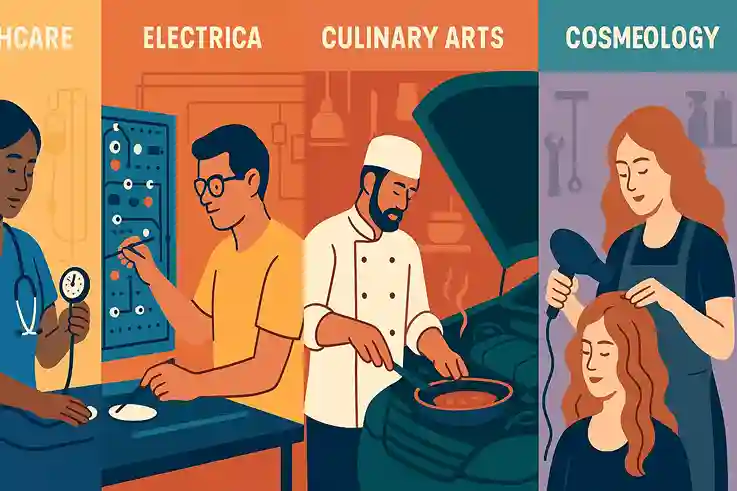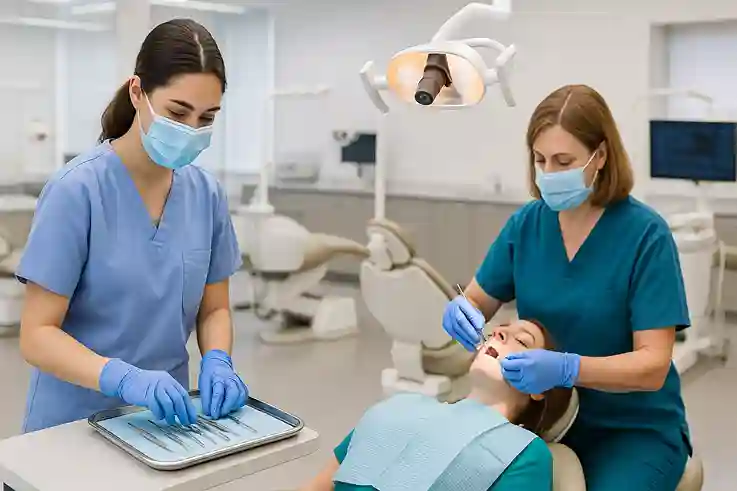Types of trade schools give students career training in focused programs. They teach practical skills instead of broad academic subjects. These schools prepare people for hands-on work in industries that need skilled workers.
Unlike traditional colleges, trade schools shorten the path to a job. Students can complete programs in months or a few years. This speed allows graduates to enter the workforce quickly and start earning sooner.
As the U.S. job market shifts, many industries face worker shortages. Trade schools unlock new opportunities in healthcare, technology, construction, and more. With the right training, students gain stability, higher pay potential, and careers that grow with demand.
What Makes Types of Trade Schools Different

Types of trade schools stand apart from traditional colleges. They focus on speed, affordability, and direct career preparation. While a four-year college demands years of study, trade schools often take months or two years. This shorter timeline helps students reach the job market quickly.
The training itself is different too. Trade schools emphasize hands-on practice over theory. Students work directly with tools, equipment, and methods used in real jobs. This approach builds confidence and job-ready skills. It also reduces the gap between classroom learning and workplace needs.
Affordability is another advantage. Tuition is usually lower than most U.S. colleges. Because students graduate sooner, they avoid large debt loads. They also start earning earlier, which speeds up financial stability. These combined benefits—fast training, practical skills, and lower cost—make trade schools attractive. For many Americans, they offer a realistic and reliable way to secure steady careers in growing industries.
Healthcare Trade Schools
Nursing Programs
Many types of trade schools prepare students for nursing careers. Practical nursing and vocational nursing programs give focused training in patient care. For example, students practice monitoring vital signs, giving medication, and supporting daily patient needs. Classes also cover safety, ethics, and communication skills. Graduates therefore enter hospitals, clinics, and long-term care centers with confidence and job-ready experience.
Career Options: Licensed Practical Nurse (LPN), Licensed Vocational Nurse (LVN), or Registered Nurse with further study.

Dental Assisting Programs
Dental assisting programs teach students how to support dentists during treatments. They train students in patient care, lab work, and office duties. In addition, students practice sterilizing tools, preparing treatment rooms, and explaining procedures to patients. Graduates often find stable jobs in private dental practices. Demand remains steady because oral health is a growing priority in the U.S.
Career Options: Dental Assistant, Orthodontic Assistant, or Office Manager in dental settings.
Medical Technology Programs
Medical technology training focuses on lab skills and diagnostic testing. Students learn to handle equipment, collect samples, and support medical teams. For instance, they practice running blood tests, preparing slides, and using advanced diagnostic machines. These roles are critical in hospitals and testing centers. Graduates therefore meet a constant need for accurate healthcare data across the U.S.
Career Options: Medical Laboratory Technician, Phlebotomist, or Clinical Laboratory Assistant.
Community Impact
Healthcare trade schools serve more than just students. They also provide local communities with skilled workers in high-demand roles. For example, nurses, dental assistants, and medical technicians all strengthen public health systems. These professionals support patient care, improve access to treatment, and fill critical gaps. At the same time, graduates earn steady pay, gain stability, and build long-term careers that grow with demand.
Technology Trade Schools

IT Programs
Information technology programs teach students how to manage networks, troubleshoot systems, and support daily operations. For example, classes cover hardware setup, software updates, and user support. These skills are valuable because every U.S. business depends on reliable technology. Graduates often move directly into entry-level IT roles.
Career Options: IT Support Specialist, Network Technician, or Systems Administrator.
Coding Programs
Coding programs focus on teaching programming languages like Python, Java, and HTML. Students learn to build websites, apps, and databases. In addition, many programs include projects that mirror real-world work. This hands-on practice helps graduates stand out. Because of high demand, coding jobs in the U.S. offer stability and strong pay.
Career Options: Web Developer, Software Developer, or Database Programmer.
Cybersecurity Programs
Cybersecurity programs prepare students to protect systems against threats and data breaches. Training includes risk analysis, security monitoring, and ethical hacking. Meanwhile, U.S. companies face major labor shortages in this field. As a result, graduates often secure jobs quickly after finishing training.
Career Options: Cybersecurity Analyst, Security Technician, or Information Security Specialist.
Stable Career Growth
Technology trade schools give students more than just technical skills. They also provide a fast route into fields with high demand. Therefore, graduates benefit from stable pay, advancement opportunities, and long-term job security. Employers value trade school training because it delivers job-ready workers. These careers also continue to grow as technology expands across healthcare, finance, retail, and nearly every U.S. industry.
Skilled Trades and Construction

Electrician Programs
Many types of trade schools train students to become electricians. Programs teach wiring, safety codes, and electrical system repair. For example, students practice installations in both residential and commercial settings. They also learn how to read blueprints, test circuits, and follow safety regulations. With U.S. housing and infrastructure growth, demand for electricians continues to rise. As a result, graduates often secure stable jobs soon after completing training.
Career Options: Residential Electrician, Commercial Electrician, or Electrical Maintenance Technician.
Plumbing Programs
Plumbing programs focus on water systems, pipe fitting, and safety standards. Students learn to install, repair, and maintain plumbing systems in homes and businesses. In addition, they study how to read blueprints, follow building codes, and apply modern plumbing technologies. Many programs also include apprenticeships that give students hands-on experience with licensed plumbers. Plumbing careers stay steady because every community relies on safe water access. Therefore, graduates often enjoy reliable job opportunities and steady income across the U.S.
Career Options: Plumber, Pipefitter, or Steamfitter.
HVAC Programs
HVAC programs cover heating, ventilation, and air conditioning systems. Students learn to repair units, maintain equipment, and manage energy efficiency. Meanwhile, extreme weather in many U.S. regions increases the need for skilled HVAC technicians. Graduates often secure jobs quickly because of constant demand.
Career Options: HVAC Technician, Refrigeration Mechanic, or Climate Control Specialist.
Carpentry Programs
Carpentry training teaches woodworking, construction methods, and blueprint reading. Students also learn to use modern tools and follow safety practices on active job sites. Therefore, carpenters play a key role in both housing and commercial building projects. Training often includes cabinetmaking, framing, and finishing work that prepares graduates for diverse roles. With ongoing U.S. construction projects, their skills remain vital. As a result, carpentry graduates often find steady work in growing communities nationwide.
Career Options: Carpenter, Cabinetmaker, or Construction Foreman.
Real-World Career Success
Graduates from skilled trade schools often find success stories close to home. For example, one student in Ohio completed an HVAC program in under two years. He quickly joined a local company, doubled his income, and now trains new hires. Stories like this show how trade schools turn practical training into stable, rewarding careers.
Creative and Design Trade Schools

Culinary Arts Programs
Many types of trade schools offer culinary arts training. Students learn cooking techniques, baking skills, and kitchen management. For example, programs often include internships in restaurants or hotels. This hands-on practice helps students build confidence and speed in real kitchens. U.S. restaurants, resorts, and catering companies continue to seek new culinary talent.
Career Options: Chef, Pastry Chef, or Restaurant Manager.
Graphic Design Programs
Graphic design programs focus on digital tools, creative layouts, and visual communication. Students practice designing websites, ads, and marketing materials. In addition, many schools require real-world projects that mimic agency work. This short training prepares graduates for creative careers in advertising, publishing, and digital media. U.S. companies value fresh design ideas to reach modern audiences.
Career Options: Graphic Designer, Digital Illustrator, or Brand Designer.
Fashion Programs
Fashion trade schools train students in sewing, textiles, and design principles. Students also study trend analysis, production, and retail planning. Meanwhile, hands-on projects help graduates create collections and portfolios that showcase their style. U.S. fashion houses, retail brands, and online businesses continue to look for skilled designers. Short training programs make it possible for students to enter the industry quickly.
Career Options: Fashion Designer, Merchandiser, or Apparel Production Specialist.
Creative Careers and Growth
Creative trade schools give students more than artistic training. They also provide quick entry into industries that reward talent and skill. Therefore, graduates gain the chance to turn passions into careers. Culinary, design, and fashion fields all rely on new voices, and trade schools deliver them.
Automotive and Aviation Training
Auto Mechanics Programs
Many types of trade schools offer training in auto mechanics. Students learn engine repair, brake systems, and electrical diagnostics. For example, programs often include shop practice with real vehicles. This hands-on work builds problem-solving skills and prepares students for busy repair shops. U.S. drivers rely on auto mechanics daily, which keeps demand strong.
Career Options: Auto Mechanic, Service Technician, or Automotive Diagnostic Specialist.
Diesel Technology Programs
Diesel technology programs focus on engines used in trucks, buses, and heavy equipment. Students learn to repair engines, manage fuel systems, and troubleshoot electronic controls. In addition, many schools partner with trucking and logistics companies for internships. Because U.S. shipping depends on diesel engines, demand for skilled technicians stays high.
Career Options: Diesel Mechanic, Fleet Maintenance Technician, or Heavy Equipment Specialist.
Aviation Repair Programs
Many types of trade schools offer aviation repair programs that prepare students for work on airplanes and helicopters. Training includes inspecting engines, maintaining safety systems, and replacing worn or damaged parts. Meanwhile, students also learn to follow FAA regulations and use specialized tools for aviation maintenance. U.S. airlines and private carriers face ongoing shortages of qualified technicians. As a result, graduates often find jobs quickly after completing certification and build lasting careers in aviation.
Career Options: Aviation Maintenance Technician, Aircraft Inspector, or Avionics Specialist.
Career Outlook
Automotive and aviation programs give students more than technical knowledge. They also create direct entry into stable transport and logistics careers. Therefore, graduates enjoy fast job placement, steady pay, and long-term growth opportunities. Employers value these skills because U.S. shipping, travel, and commerce depend on reliable vehicles and aircraft. With constant demand, these fields remain essential to the U.S. economy and continue to offer secure career paths.
Beauty and Personal Care Schools
Cosmetology Programs
Many types of trade schools provide cosmetology training. Students learn hair styling, coloring, nail care, and makeup application. For example, programs often include practice in student salons with real clients. This real-world training helps students master customer service and technical skills. The experience also builds confidence and prepares them for state licensing exams. As a result, graduates enter the beauty industry ready to serve clients and grow careers.
Career Options: Hair Stylist, Nail Technician, or Makeup Artist.
Barbering Programs
Barbering programs focus on haircutting, beard grooming, and shaving techniques. Students also study sanitation, customer service, and shop management. In addition, programs often include hands-on practice in student barbershops that serve real clients. This training helps students gain confidence, speed, and strong communication skills. Many programs also guide students toward licensing and essential business knowledge. Because of steady client demand, barbering offers reliable career paths in communities across the U.S. As a result, graduates can build loyal customer bases or even open their own shops.
Career Options: Barber, Men’s Grooming Specialist, or Shop Owner.
Skincare Programs
Skincare programs train students in facials, waxing, and advanced treatments. Classes also cover anatomy, product knowledge, and spa management. Meanwhile, students often practice in supervised spa settings that prepare them for real client interactions. This hands-on training builds skill and confidence while reinforcing safety standards. U.S. demand for skincare services continues to grow with rising interest in wellness and beauty. As a result, graduates can quickly build loyal client bases and create stable careers in the industry.
Career Options: Esthetician, Spa Technician, or Skincare Specialist.
Independent Careers
Beauty and personal care schools prepare students for more than employment. They also teach business skills that help graduates open salons, spas, or barber shops. Therefore, many graduates become entrepreneurs, building flexible careers with strong earning potential. With personal services always in demand across the U.S., this field remains both steady and rewarding.
Choosing the Right Trade School
Accreditation Matters
Many types of trade schools stress the importance of accreditation. Students should always check accreditation before enrolling. Accredited schools meet quality standards and prepare students for licensing exams. For example, employers often prefer graduates from accredited programs. Choosing the right trade school ensures that training is both recognized and respected.
Program Length and Structure
Program length in many types of trade schools varies by field. Some programs finish in months, while others may take two years. In addition, students should review class schedules, hands-on training, and certification requirements. Matching these details to personal goals helps students stay on track and finish successfully.
Job Placement and Career Goals
Many types of trade schools publish job placement rates for graduates. These numbers give clear insight into career outcomes. Meanwhile, students should compare placement support services, such as internships, apprenticeships, or career counseling. Aligning school choice with long-term career goals often leads to stronger success and more stable opportunities.
Costs and Financial Aid
Tuition costs differ across many types of trade schools and programs. Therefore, students must compare fees, supplies, and potential earnings. Financial aid, scholarships, and grants may also reduce the burden. Considering costs alongside career opportunities creates a clearer and more realistic financial plan.
Local and Regional Demand
Students should research the demand for specific trades in their area. For instance, some regions need more electricians, while others seek healthcare workers. Matching school training with local job markets increases the chance of steady employment.
The Database of Accredited Postsecondary Institutions and Programs (DAPIP) — run by the U.S. Department of Education — lets you search for accredited institutions and programs.
Comparison of Different Types of Trade Schools
| Trade School Type | Common Programs | Typical Training Length | Career Options |
|---|---|---|---|
| Healthcare | Nursing, Dental Assisting, Medical Tech | 1–2 years | Nurse, Dental Assistant, Lab Technician |
| Technology | IT, Coding, Cybersecurity | 6 months – 2 years | IT Specialist, Web Developer, Cybersecurity Analyst |
| Skilled Trades | Electrician, Plumbing, HVAC, Carpentry | 1–2 years + apprenticeship | Electrician, Plumber, HVAC Technician, Carpenter |
| Creative & Design | Culinary Arts, Graphic Design, Fashion | 6 months – 2 years | Chef, Graphic Designer, Fashion Designer |
| Automotive & Aviation | Auto Mechanics, Diesel Tech, Aviation Repair | 1–2 years + certification | Auto Mechanic, Diesel Technician, Aviation Maintenance Tech |
| Beauty & Personal Care | Cosmetology, Barbering, Skincare | 9 months – 1.5 years | Hair Stylist, Barber, Esthetician |
“The best investment isn’t always four years in a classroom—sometimes it’s a trade school that puts tools, skills, and opportunity in your hands.”
FAQs About Types of Trade Schools
Conclusion
Exploring different types of trade schools can open doors to fast, practical, and rewarding careers. These schools provide focused training that leads directly to stable jobs. In addition, they often cost less and prepare students to earn sooner than a four-year degree. From healthcare to technology, skilled trades to creative fields, trade schools continue to shape the future of the U.S. workforce.
Therefore, students who match their goals with the right school gain lasting benefits. They find opportunities that bring financial stability, personal growth, and community impact.
What do you think about trade schools as a career path?
Share your thoughts, experiences, or goals in the comments below. Your story might inspire someone else to explore new opportunities.

Ellie Clark is a passionate blogger with a specialty in education, where she shares insights on learning methods, study strategies, and ways to make knowledge more accessible. With a background in teaching and a love for lifelong learning, she brings clarity and creativity to her writing, helping readers of all ages unlock their potential. While education remains her core focus, Ellie also writes on a variety of other topics, including lifestyle, travel, and personal development, giving her blog a well-rounded appeal.
When she’s not writing, Ellie enjoys reading, exploring new cultures, and spending time in nature. Her approachable style and thoughtful advice make her a trusted voice for readers seeking both guidance and inspiration.


